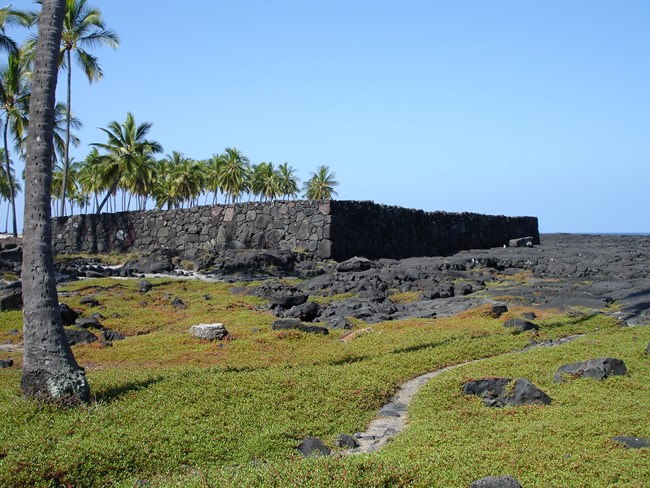|
Take a walk back in time to old Hawaiʻi as it was many centuries ago. Kiʻi (carved statues) surround the Hale o Keawe, the former resting area of 23 Keawe line chiefs. The Pā Puʻuhonua (Great Wall), spanning up to 12 feet tall, 18 feet wide and over 950 feet long, will amaze you with its huge rocks fitting together like locking puzzle pieces. Footpaths take you past Hawaiian heiau (temples) and other ancient structures. Puʻuhonua o Hōnaunau has many places visitors can go to experience the Hawaiʻi of yesterday and today. How to Explore
The Royal GroundsIn the past, aliʻi (chiefs) entered the Royal Grounds from Keoneʻele Cove by canoe. The pū (conch shell) is sounded to warn of their approach. As the canoe makes land fall, other members of the royal court stroll past the royal fishponds, looking for a choice fish for dinner. Other chiefs may engage in a game of kōnane. The beauty, splendor and history of the Royal Grounds are still felt as you walk along the trails once reserved for Hawaiian royalty. Learn more about the Royal Grounds. Things to see
The PuʻuhonuaIn the time of kapu, a woman eats with a man. A makaʻāinana (commoner) casts his shadow on an aliʻi. Someone catches a fish out of season. Break these or any other kapu, and you face the ultimate punishment of death. Your only chance of survival is to elude your pursuers on foot, make your way to the coast, and swim to the Puʻuhonua. If you make it--and many do not--you may be absolved by a priest. Learn more about the Puʻuhonua. 
Things to See
RestrictionsThe Royal Grounds and Puʻuhonua are important cultural sites and the park strives to maintain the cultural landscape. The area maps show the boundaries of the Pu'uhonua and Royal Grounds and describe the activity restrictions in each area. For more detailed information about park rules and regulations read through the Superintendent's Compendium. |
Last updated: December 1, 2025
